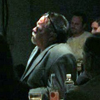New-music advocate Bonnie Wright began the fall installments of her Fresh Sound at Bread & Salt concert series with a (literal) bang on Jan. 15 through a performance by Red Fish Blue Fish, the innovative percussion ensemble directed and founded by Steve Schick and featuring Leah Bowden, Dustin Donahue, Chris Clarino, Fiona Digney and Ryan Nestor.
The group unveiled the appropriately titled "Timber" by composer Michael Gordon, a provocative 60-minute piece for six graduated, amplified 2x4s. That's not a typo. Each member used mallets to tap on 2x4s mounted on sawhorses arranged in an unequally sided hexagon in the center of the large industrial warehouse space, surrounded by the audience.
All six of the musicians wore earbuds to monitor a click-track that the audience did not hear. After Bowden began alone with one rhythmic phrase, the others joined in, either doubling that phrase or playing counter ideas, spreading the mallets around the boards to achieve overtones and moving toward the first in a series of crescendos. A sound engineer off to the side of the group manipulated some of those sounds to achieve an amorphous droning bass, similar to a large tabla.
One of the many fascinating aspects of this performance came when the group would intensify the dynamics -- at that point, the multiple layered overtones would swirl into the high ceiling and produce long pitches that sounded like a woman singing. I had to ask after the show if that was someone on tape or some sort of hidden electronics producing that effect. Turns out it was just the magic of acoustics.
After achieving a dizzying layering of polyrhythmic structures on one idea, Schick would steer the group into a different rhythm, after which the ideas would double, layer, conflict and transform from super quiet to almost unbearably loud. At times it sounded like six different rhythms were struggling to exist in the same space. From the perspective of this listener, the amount of concentration required to pull this off seemed to be superhuman. At varying points, the main rhythms and the polyrhythms felt logical and precise -- sort of a combination of the minimalism of Steve Reich (in an untempered sense) or Balinese Gamelan music -- but at other times the effect was more mechanical, like the sound of tennis shoes in a clothes dryer or, at one point, like an OCD carpenter trying to even the ends of a stack of studs with a framing hammer.
Each player's 2x4 was of a different length, and they were all supported at the nodal points to facilitate maximum vibration. Even still, it was amazing to hear how many different pitches could be achieved simply by where the mallets hit the boards, how hard they were struck, and whether the players choked up on them or held them at their ends.
About halfway through the piece, each player struck the ends of their own boards with one mallet, and the ends of the board next to them with the other. This achieved a different tonal effect, and a sense of motion was consistently achieved through changes in volume and with different members of the group pairing off in different configurations. This was an extremely challenging idea, and the music itself was daunting for the performers -- the score was in front of each musician on a laptop computer with foot-activated page changing -- but Red Fish Blue Fish pretty much knocked it out of the park, resulting in a well-earned and sustained ovation at the end.

Robert Bush is a freelance jazz writer who has been exploring the San Diego improvised music scene for more than 30 years.

